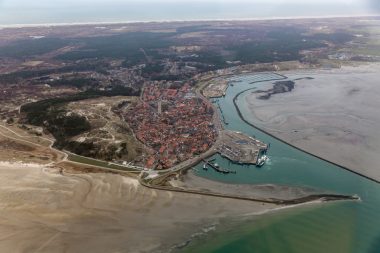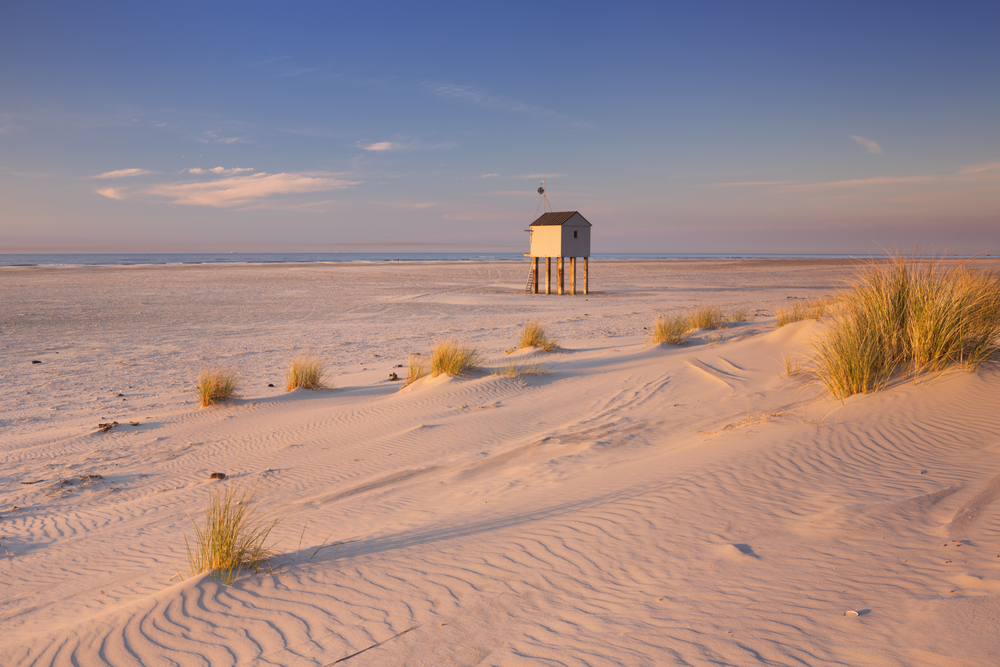Hardly any other North Sea island is as varied and suitable for every type of holidaymaker as the West Frisian island of Terschelling in the Netherlands. Whether kite surfers, beach hikers, ornithologists, cyclists or partygoers – everyone feels at home on Terschelling. A diverse landscape is spread over a length of almost 29 kilometres and a width of 4.5 kilometres: extensive beaches, high dune belts, polder plains, forests and swamps in which a remarkable variety of birds and butterflies cavort.
The crossing from Harlingen to Terschelling
The journey begins in the ferry port of Harlingen, the car may be with you, but does not have to. There is sufficient long-term parking space available in Harlingen. Those in a hurry use the fast ferry (but without a car), which reaches Terschelling in 45 minutes. A holiday from the very beginning is the journey with the large car ferry, which takes 120 minutes for the crossing. It is incomparable when the ponderous car ferry carefully feels its way through the fairway of the Wadden Sea in serpentine lines, while you watch the seals lolling in the sun on glittering sandbanks from the deck with binoculars.
The first impression – arrival in West-Terschelling

Once on the island, you will find yourself in West-Terschelling, one of the two liveliest towns on the island. In view of 70 kilometres of developed cycle paths, the most practical means of transport is the bicycle. Just opposite the ferry pier you can rent one and head for your accommodation in true Dutch style. Your luggage will be brought there by car from your rental company. West-Terschelling offers many accommodations, restaurants, cafés and shops in busy shopping streets as well as a marina. There is also an indoor swimming pool and an indoor tennis court. The Centre for Nature and Landscape houses a nature museum and a sea aquarium. The village is dominated by the lighthouse “De Brandaris”, which is visible from afar, but unfortunately is not allowed to be climbed. The choice of accommodation is largest in West-Terschelling. Outside the village there are some campsites.
Terschelling’s villages introduce themselves
In the middle of the island, the village of Midsland has made a name for itself as a party location. There are plenty of shops to provide the necessary outfit. Cafés, pubs, affordable restaurants and nightclubs cater to the younger crowd that comes to the island to party, especially during the summer holidays.
The further east you go, the quieter the villages become. Formerum is a quiet, family-friendly resort. This is where Terschelling’s only windmill is located. In the wreck museum, objects recovered from shipwrecks from the period from 1650 to the present day can be viewed.
In Hoorn, a small shopping street satisfies daily and tourist needs. Worth seeing is the “Sint Janskerk”, a church from the 13th century. In a small museum below the tower, coins and other objects are exhibited that were found in the ground during restoration work. The Agricultural Museum with adjoining children’s farm is a popular destination for families with children.
Oosterend is the easternmost village on the island and the starting point for trips to the nature reserve “De Boschplaat”. The Boschplaat is 10 kilometres long and 5 kilometres wide. About 65 species of birds breed here, including the lesser black-backed gull, the herring gull and the spoonbill. As a result, the nature reserve is not open to the public during the breeding season between 15 March and 15 August. However, a narrow sandy path on the dune summit leads along the breeding area, which is open all year round.
The North Sea beach – Terschelling’s capital
Many holidaymakers come to Terschelling because of the beach. On 30 kilometres of beach, everyone will find their own place. At West-Terschelling there is still a lively hustle and bustle, between Formerum and Oosterend you have the beach almost all to yourself. There are several beach pavilions along the beach. Here you can eat or drink something and rent umbrellas and sunbeds.
An insider tip is the beach pavilion “Heartbreak Hotel”, which is the easternmost beach pavilion on the island in Oosterend – in the immediate vicinity of the “Boschplaat”. Furnished in the style of the 50s and 60s, the unforgettable hits of Elvis Presley, Chuck Berry or Johnny Cash can be heard from the loudspeakers. Some of the beach pavilions are even open in winter – a fantastic experience to stop for a warm drink with a sea view after a stormy walk on the beach. Due to the vastness of the beach, everyone can practice their beach sport: swimming, surfing, kiting, sand yachting, beach rides, flying kites.
It never gets boring on Terschelling

Even away from the beach, everyone gets their money’s worth. In addition to cycling, hiking is the best way to discover nature. There are 250 kilometers of hiking trails that crisscross the island. A mudflat hike is also one of the options, but it should not be done without a local guide.
Every year in June, Terschelling is in a state of emergency for 10 days. The famous “Oerol” festival attracts thousands of visitors to the island with its theatre and music performances. If you want to visit the island at this time, you should book your accommodation early, as all accommodations are booked out well in advance.
Red, round and healthy – the cranberry
A trademark of the island is the cranberries, a cranberry originally native to North America, which washed up on the island after shipwrecks and multiplied wildly. The health-promoting effect of cranberries was quickly discovered and marketed. Cranberries are available for sale as juice, jelly or jam, as well as wine or liqueur.




